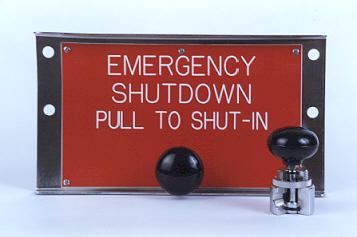Shutdown Valves (SDV) are common apply in oil and gas production system for safe and proper isolation purpose to minimize escalation of hazardous from one system to another system. General shutdown valve is controlled by a high integrity Emergency Shutdown System (ESDS).
A shutdown valve shall equipped with the following features :
i) Tie Shut Off (TSO)
- Zero/minimum leakage shall be expected for a device act as shutdown valve. Generally a Shutdown valve seat leakage shall pass the seat leakage testing per API 508 and/or ISO 5208.
ii) Firesafe
- shutdown valve is expected to work promptly even though it expose to external fire attacks. thus, shutdown valve body shall be fire rated according to API 607 for soft seated valve or API 6FA for API 6A & API 6D valves or BS 6755 Part 2.
iii) Fast action (From Full Open - Full Close)
- A shutdown valve shall act fast to minimize the escalation of hazards. Generally a quarter ball valve is the excellent device in quick action. As rule of thumb, shutdown valve shall be capable of begin it closing action within 10 seconds of activation, and time taken from Full open to Full Close is within 1-2 seconds per inch of shutdown valve size. However, this shall be compliant to overall safety philosophy. Proper selection and sizing of actuator to ensure above requirements are fulfilled.
iv) Minimum passing (during closing of shutdown valve)
- The feature is required to minimize the potential of overpressure of Low pressure system and spurious trip. A shutdown valve with equal% characteristic (most ball valve will have this feature. However, this shall be confirmed with valve supplier) is preferred type. With equal% characteristic, it can operate with 10% valve closure give 20% flow reduction, 20% closure give 50% closure...the closure of valve is fast and minimize inventory passing.
v) Minimum disturbance / turbulence to process fluid
- This feature is to minimize unnecessary energy lost. Reduced Bore (RB) ball valve having hole in the middle would minimize flow direction change and turbulence. Full Bore (FB) ball valve virtually like a pipe- significantly minimize energy lost.
vi) Fail-safe
- A shutdown valve actuator shall pneumatic/hydraulic fail-safe spring-return type. Generally a shutdown valve failed to close (FC). Electrical driven type shall not be used.
vii) Manual field reset
- A shutdown valve shall be reset manual at field. The operator shall ensure the system is clear and safe and reset on site. No remote reset is allowed.
viii) Clear physical indicator
- Shutdown valve shall be equipped with visible external valve position indicators to provide clear positioning and status of a shutdown valve.
ix) Position switches
Position switches shall be provided on shutdown valve to provide clear positioning and status of a shutdown valve to control room.
x) Partial Stroke Testing of Shutdown Valve
A shutdown valve in critical service e.g. Pipeline outgoing and incoming shutdown valve (ESDV) will required periodically partial stroke testing in order to maintain / increase it reliability, availability & SIL level.
xi) Accumulator
Some shutdown valve may be equipped with accumulator to facilitate valve stroking and /or reopen in the event maloperation.
xii) Second Solenoid valve
Shutdown valve in critical service may be equipped with second solenoid valve to increase reliability and availability.
Above has presented 12 features of shutdown valve. Some operating company may have their additional requirements and limitation on shutdown valve.
Related topics
- ERRATA - API Std 521, Pressure Relieving and Depressuring Systems
- Requirement of overpressure protection devices on system design to PIPING code
- ESD Selection Guide, Metso Automation, Issue 4/2001
- Partial Stroke Testing of Emergency Shutdown Valves, ACM Automation
- Achieving High SIL Ratings with Partial Stroke Testing of Valves, ACM Automation

No comments:
Post a Comment